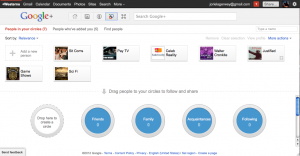The Google+ Assignment
 My semester at Notre Dame started last week, and along with it the beginning of a grand experiment with the Facebook, er, Google+ Assignment. At the last minute, I rejected Facebook in favor of Google+ because, according to their terms of service, Facebook is a bit of a stickler for using real, birth certificate and driver’s license names, and Google+ seems to care slightly less. And what fun would crafting an online persona be if you had to use your real name?
My semester at Notre Dame started last week, and along with it the beginning of a grand experiment with the Facebook, er, Google+ Assignment. At the last minute, I rejected Facebook in favor of Google+ because, according to their terms of service, Facebook is a bit of a stickler for using real, birth certificate and driver’s license names, and Google+ seems to care slightly less. And what fun would crafting an online persona be if you had to use your real name?
This is the first in a series of posts describing and reflecting on the goals, challenges, successes, failures, and student responses to a social media based assignment. While I am by no means the first to assign students to create social media personae or tweet about media theory, I hope that sharing my experiences will garner some brilliant tips and suggestions, spur a conversation about the values and pitfalls of this kind of digital pedagogy, and perhaps even inspire someone to try out something similar. In light of last weekend’s New York Times piece “Blogs vs. Term Papers” and the response from Cathy Davidson, a Duke University English professor and co-founder of the Digital Humanities community HASTAC, the concept of the Google+ assignment seems especially timely.
The class is Contemporary TV Genres, and at our first meeting, each student selected a genre for which they would create a Google+ profile. During the semester, they must write an About page defining their genre and its history. They must post pictures and links illustrating past and present iterations of the genre, complete with comments and captions analyzing their significance to the genre’s evolution over time. They must shoot or edit at least one video, and they must interact with each other via wall posts, relationship statuses, +1s (Likes in Facebook parlance), sub-circles (Google+’s organizing principle is the Circle, rather than Facebook’s List), and comments on classmates’ posts. The tasks cover all levels of thinking from recall to evaluation and application, and require students to practice writing, research, and analysis skills. In short, it encompasses all of the course’s learning goals, and if it works, we’ll create a community of characters/genres that is fully interactive and has the bonuses of being fun and of linking classroom content to lived social experience.
In speaking to others who have experimented with similar assignments, the number one problem cited was assessment. How do you assign a grade for a student impersonating the procedural genre changing their relationship status to “Married to Melodrama?” We all know grading is subjective, but how to create a rubric for something like this? I’ve scheduled four checkpoints during the semester, at which time each student will receive a letter grade and written feedback. Each item on the Google+ page is assigned a point value. 1 point possible for including a hometown, 25 possible points for writing the historical About page, for example. One advantage of this type of assignment is the ease with which students can revise, change, rewrite, etc. in response to feedback. The four checkpoint grades will be averaged for a final grade at the end of the semester.
Besides the practicalities of assessment, of course the biggest question is why. Why do this instead of response papers or individualized research or analysis essays. In fact students will also have to write 3 short analysis papers representing different aspects of or stakeholders in TV genres. But the Google+ assignment aims to link learning with social technologies students are already using, spurring students to use the tools and consume the social media more critically, and making the classroom material relevant to and even part of their daily activities…We’ll see how it goes!




Excellent post, Jorie, and I look forward to seeing how your experiment develops over the semester! Last year, I started a Facebook group for each of my classes, with mixed results. The FB group isn’t an assignment (the students don’t have to join), but I give them extra credit for contributing links (to articles, video, etc.) over the course of the semester.
I enjoy the group, as it gives me an opportunity to share news items and other internet tidbits with them in a less formal/organized way. Students who actively use the group have found it helpful in working on their own research projects, or in-class presentations. (For instance, I’ll tag a post about SOPA with the names of students who are assigned to present on SOPA in a few weeks. They like that!)
I’ve had mixed results, as I said, depending on the group of students and the material of the class. My media industries course this semester has not fully embraced the group (less than half of the students joined, no one has posted), but my gender/sexuality course is obsessed with it (46 out of 50 students have joined, with upwards of 12 posts PER DAY).
All-in-all, I’ve found it to be a useful tool and resource for those students who embrace it, and I look forward to hearing more about your experiences using Google+ for a semester-long project! Thanks so much for sharing!
Thanks for your response, Erin. I’ve used blogs in the past to do something similar to what you described in your Facebook group. I’m hoping this gets even more interactive and that the students start to see it as a sort of role-playing game. So far, I definitely have varied levels of participation from student to student. I have a small class though (16) and most of them are upperclassmen who know each other and feel comfortable interacting and enjoy the creativity involved. The first check point is in about 2 weeks, so that’ll be the real test of how it’s going. I’ll be keeping you all posted!